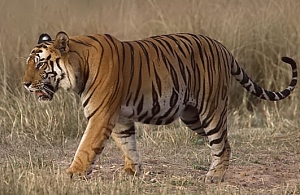Even as the State prepares for the national tiger estimation which
will start by the end of this year, the second phase of annual predator
and ungulate survey will kick off from next month in Similipal Tiger
Reserve (STR), the State’s first designated tiger habitat.
The STR management has already begun the ground work for the survey by way of training the staff and putting in place the camera traps basing on the outcome of the first phase. Two sets of cameras will be installed at the locations identified to catch the stripes of the master predators from both sides so that identification of each tiger can be ascertained.
For this, the tiger reserve management may seek support from the Wildlife Institute of India (WII) and the National Tiger Conservation Authority for accurate identification of the tigers.
“We already have the outcome of the first phase of the survey and we will go about the second phase basing on it,” Field Director of STR A K Nayak said.
Interestingly, this survey is being done by the State Forest department entirely on its own. The results of the predator and ungulate survey are expected to be known by February-March, which will give a fresh status of tigers in Similipal.
Before the State completes its annual exercise, the NTCA-initiated national level estimation will have begun by December. The last estimation was held in 2010 and before that, in 2006. The 2010 estimation had put the population in Similipal in the range of 12 to 34, about 23. The national estimation will see a departure from the past. Instead of landscape-wise estimation, this time the survey will come out with TR-wise data for better comprehension of the population of the predators, co-predators and their prey base, Nayak said.
The national exercise, as per the NTCA, is scheduled to be carried out in three phases. The first phase will see collection of ground data using an eight-day protocol, while Phase II will use remote-sensing data to generate landscape and other information. In the last leg, camera traps and distance sampling for computing density of tigers will be conducted. After the three phases are completed, the NTCA will generate the tiger reserve level monitoring data. During the third phase, experts from WII will visit the tiger-bearing States to monitor the exercise and collect information.
The NTCA provides full assistance for conducting the eight-day field protocol towards primary data collection, orientation, training workshops for the TR staff as well as top management, including Field Directors. The regional workshops for the forest officials are already underway.
source
The STR management has already begun the ground work for the survey by way of training the staff and putting in place the camera traps basing on the outcome of the first phase. Two sets of cameras will be installed at the locations identified to catch the stripes of the master predators from both sides so that identification of each tiger can be ascertained.
For this, the tiger reserve management may seek support from the Wildlife Institute of India (WII) and the National Tiger Conservation Authority for accurate identification of the tigers.
“We already have the outcome of the first phase of the survey and we will go about the second phase basing on it,” Field Director of STR A K Nayak said.
Interestingly, this survey is being done by the State Forest department entirely on its own. The results of the predator and ungulate survey are expected to be known by February-March, which will give a fresh status of tigers in Similipal.
Before the State completes its annual exercise, the NTCA-initiated national level estimation will have begun by December. The last estimation was held in 2010 and before that, in 2006. The 2010 estimation had put the population in Similipal in the range of 12 to 34, about 23. The national estimation will see a departure from the past. Instead of landscape-wise estimation, this time the survey will come out with TR-wise data for better comprehension of the population of the predators, co-predators and their prey base, Nayak said.
The national exercise, as per the NTCA, is scheduled to be carried out in three phases. The first phase will see collection of ground data using an eight-day protocol, while Phase II will use remote-sensing data to generate landscape and other information. In the last leg, camera traps and distance sampling for computing density of tigers will be conducted. After the three phases are completed, the NTCA will generate the tiger reserve level monitoring data. During the third phase, experts from WII will visit the tiger-bearing States to monitor the exercise and collect information.
The NTCA provides full assistance for conducting the eight-day field protocol towards primary data collection, orientation, training workshops for the TR staff as well as top management, including Field Directors. The regional workshops for the forest officials are already underway.
source

No comments:
Post a Comment